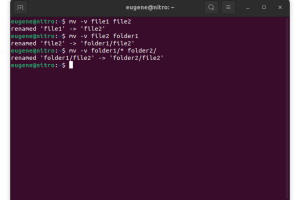In this article you will learn how to find files in Linux using different tools.
The most popular file search tools in Linux
The “find” command cheatsheet
Searching by file name
“Find” is one of the most popular tools to search files in Linux. When you know the file name you can search for it using command below. Replace “/home” with a folder to search through and “filename.txt” with the file name.
$ find /home -name filename.txt
To search the current folder for a file replace “/home” with a dot (.) symbol:
$ find . -name Documents.zip ./Documents.zip
When you do not know the exact file name use the regular expression to look for a match. The asterisk (*) symbol matches any character set after the “Documents” keyword.
$ find /home -name "Documents*" /home/eugene/Documents.zip /home/eugene/Documents /home/eugene/Phone/Documents
Searching by the modification date
To search for files that were modified today add “-mtime” key to the find command:
$ find /home -mtime 0
For example lets find pictures that were modified 10 days ago:
$ find Pictures/ -mtime 10 Pictures/Screenshots/Screenshot from 2023-11-03 10-29-49.png
Searching by file type
The “find” command in Linux allows you to search for files based on their type. Here are some examples:
Search for Directories: To find all directories within a specified path, use the -type d option.
$ find /home -type d
Search for Regular Files: Conversely, to locate regular files, use the -type f option.
$ find /home -type f -name "*.txt"
Search for Symbolic Links: To search for symbolic links, employ the -type l option.
$ find /home -type l -name "linkname"
Search for Specific File Extensions: Narrow down your search by specifying file extensions.
$ find /home -type f -name "*.jpg"
Combining Criteria
You can combine multiple criteria to make your searches more precise. Here’s an example:
Search for Modified Files with a Specific Extension: Find files modified in the last 7 days with the extension “.log”.
$ find /var/logs -type f -name "*.log" -mtime -7
Search for Files Modified Between a Date Range: Locate files modified between November 1, 2023, and November 5, 2023.
$ find /home -newermt 2023-11-01 ! -newermt 2023-11-06
Additional “find” Command Options
Ignoring Case Sensitivity: If you want the search to be case-insensitive, use the -iname option.
$ find /home -iname "document*"
Limiting Depth of Search: Limit the search depth to a specific level with the -maxdepth option.
$ find /home -maxdepth 2 -name "*.txt"
Excluding Specific Directories: Exclude certain directories from your search using the -not or ! option.
$ find /home -type f -name "*.txt" -not -path "/home/user/exclude/*"
Remember, mastering the “find” command can significantly enhance your ability to navigate and manage files in a Linux environment. Experiment with different options to tailor your searches according to specific criteria.
Search by file content using “grep” command
When it comes to finding specific content within files, the “grep” command becomes your go-to tool. It allows you to search for patterns or text strings within one or multiple files. Here’s a quick cheatsheet to get you started:
Basic Content Search: To search for a specific string in a file, use the following syntax
$ grep "search_string" filename
Replace “search_string” with the text you’re looking for and “filename” with the name of the file.
Search in Multiple Files: If you want to search through multiple files, provide a wildcard or a specific file pattern
$ grep "pattern" /path/to/files/*.txt
Case-Insensitive Search: Make your search case-insensitive with the -i option
$ grep -i "pattern" filename
Display Line Numbers: If you want to know the line numbers where the pattern is found, use the -n option
$ grep -n "pattern" filename
Display Only File Names: To show only the names of files containing the pattern, use the -l option
$ grep -l "pattern" /path/to/files/*.txt
Search Recursively: If you want to search for a pattern in all files within a directory and its subdirectories, use the -r option
$ grep -r "pattern" /path/to/directory
Exclude Files or Directories: Exclude certain files or directories from your search with the –exclude option
$ grep "pattern" --exclude=*.log /path/to/files/*
Search for Whole Words: Use the -w option to search for whole words, preventing partial matches
$ grep -w "word" filename
Advanced “grep” Usage
Search for Inverted Matches: Invert the match to display lines that do not contain the specified pattern using the -v option
$ grep -v "pattern" filename
Counting Matches: If you want to know how many lines contain the pattern, use the -c option:
$ grep -c "pattern" filename
Displaying Matching Text Only: Show only the text that matches the pattern with the -o option:
$ grep -o "pattern" filename
Recursive Search with Line Numbers: Combine options for a comprehensive search, for example:
$ grep -r -n "pattern" /path/to/directory
Mastering the “grep” command allows you to swiftly locate specific content within files, making it an indispensable tool for efficient file exploration in a Linux environment. Experiment with different options to tailor your searches and uncover the information you need.
Alternative file search methods
In addition to the powerful “find” and “grep” commands, there are alternative methods for searching files in a Linux environment. Let’s explore a few:
Find files using Python script
Sometimes, a custom Python script can provide more flexibility in file searching. Here’s a simple example using Python’s os and fnmatch modules:
import os
from fnmatch import fnmatch
def find_files(directory, pattern):
for root, dirs, files in os.walk(directory):
for file in files:
if fnmatch(file, pattern):
print(os.path.join(root, file))
# Usage
find_files('/path/to/search', '*.txt')This script walks through the directory and its subdirectories, matching files based on the specified pattern. Customize the find_files function to suit your specific search criteria.
The “locate” Command
The “locate” command is another efficient way to find files on a Linux system. It uses a pre-built index, making searches faster compared to the “find” command. However, keep in mind that the index needs regular updates to include recent changes.
Update the Locate Database:
$ sudo updatedb
Search for Files:
$ locate filename.txt
Using the “which” Command
If you’re looking for the location of an executable in your system’s PATH, the “which” command can help.
Find Executable Location:
$ which executable_name
Using “fd” – A Fast and User-friendly Alternative to “find”
The “fd” command is a fast and user-friendly alternative to “find.” It comes with a simplified syntax and colorized output.
Install fd:
$ sudo apt-get install fd-find # For Ubuntu/Debian $ sudo dnf install fd # For Fedora
Search for Files:
$ fdfind Documents Phone/Documents Documents Documents.zip
Custom Scripts and Alias
Lastly, you can create custom shell scripts or aliases to streamline your file search process. For instance:
# Custom Alias alias findtxt='find /path/to/search -name "*.txt"' # Usage $ findtxt
Custom scripts and aliases allow you to create shortcuts for your specific file searching needs, enhancing your workflow.
Find Files in Linux using Bash script
Creating and using a bash script helps to automate repetitive file search tasks in Linux. Below is an example of a simple Bash script that searches for files based on a provided pattern:
#!/bin/bash # Bash script to find files based on a pattern if [ $# -ne 2 ]; then echo "Usage: $0 <directory> <pattern>" exit 1 fi directory=$1 pattern=$2 # Check if the directory exists if [ ! -d "$directory" ]; then echo "Error: Directory $directory not found." exit 1 fi # Use find command to search for files find "$directory" -name "$pattern" -print
Save this script to a file, for example, find_files.sh, and make it executable with the following command:
$ chmod +x find_files.sh
Now, you can use the script to search for files by providing the directory and pattern as arguments:
$ ./find_files.sh /path/to/search "*.txt"
This script checks if the correct number of arguments is provided and whether the specified directory exists. It then uses the find command to search for files based on the given pattern.
Bonus: how to search through images in Linux
On Linux, there are several tools and methods for image searching, each offering unique features and capabilities. Here are a few options:
“find” Command with File Type Filtering:
The standard “find” command can be used to locate image files based on their file types. For example, to find all JPEG files in a directory and its subdirectories:
$ find /path/to/images -type f -name "*.jpg"
The “fdfind” Command:
The “fdfind” command, a fast and user-friendly alternative to “find,” can also be used to search for image files. Install it if you haven’t already:
$ sudo apt-get install fd-find # For Ubuntu/Debian $ sudo dnf install fd # For Fedora
Search for images with a specific extension:
$ fdfind -e jpg
The “locate” Command
The “locate” command can be used for quick searches, especially if an updated database is maintained:
$ locate '*.jpg'
Remember to update the locate database regularly for recent changes:
$ sudo updatedb
“grep” Command for Specific Image Names:
If you have a specific naming convention for your image files, you can use the “grep” command to search for them:
$ grep -r 'pattern' /path/to/images
Replace ‘pattern’ with a part of the image file name.
“file” Command
The “file” command can identify file types, helping you filter out image files:
$ file /path/to/images/*
Look for lines that include “image” to identify image files.
“feh” Image Viewer with Filelist
If you have a list of image files and want to view them, the “feh” image viewer allows you to create a filelist:
$ feh -f $(find /path/to/images -type f -name "*.jpg")
This opens an image viewer with a filelist of all JPEG files in the specified directory.
Using Image Metadata Tools
If your images have metadata, you can use tools like “exiftool” to search based on image properties:
$ exiftool -filename -r /path/to/images | grep 'search_term'
Graphical File Managers
Graphical file managers like Nautilus, Dolphin, or Thunar often provide search functionalities. You can navigate to the directory and use the search bar.
Tag-Based Image Organizers
Tools like “digiKam” or “Shotwell” offer image organization based on tags. Tag your images and use these tools to search based on tags.
Summary
In conclusion, mastering file search on Linux involves understanding and combining various commands, tools, and scripting techniques. Whether you’re a command-line enthusiast or prefer graphical interfaces, this guide equips you with the knowledge to navigate and search for files seamlessly in a Linux environment. Happy file hunting!






